
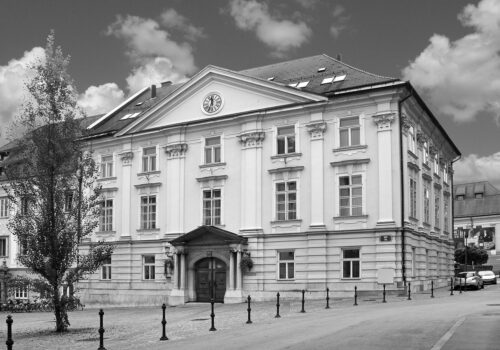

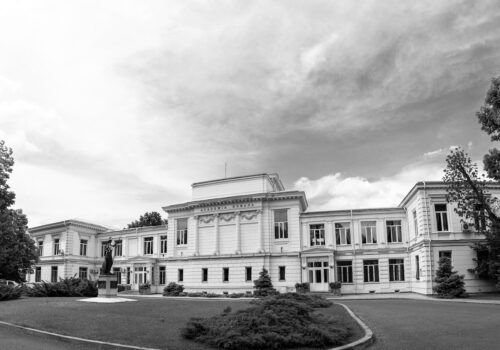

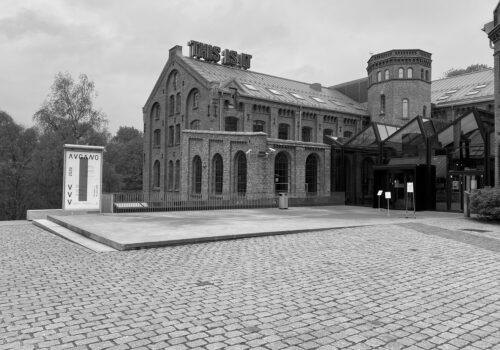

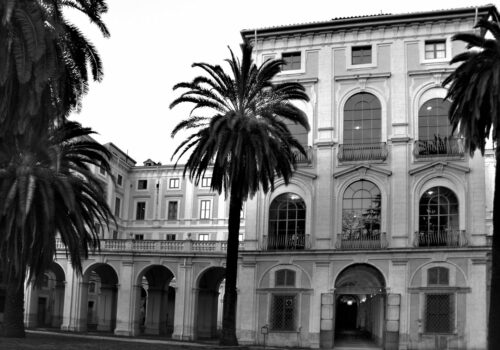
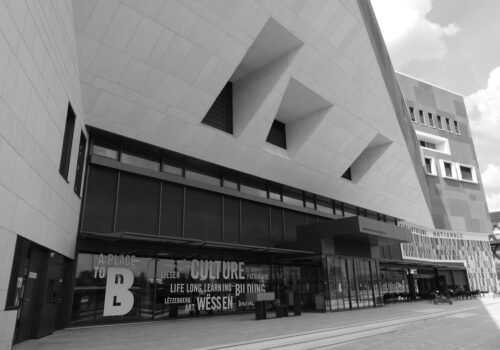
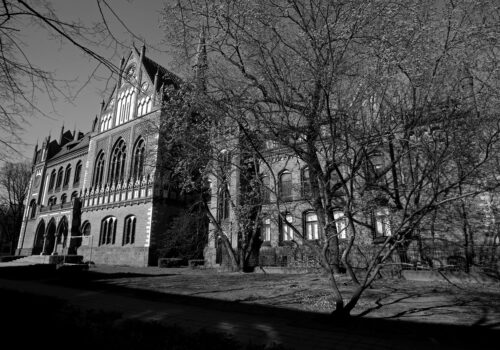
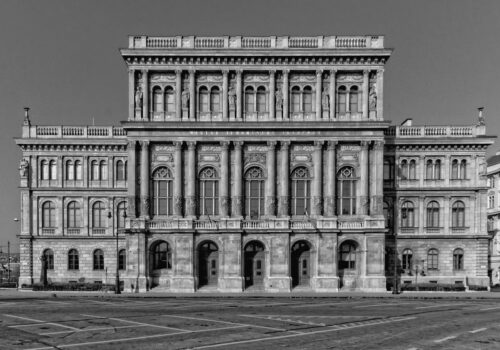

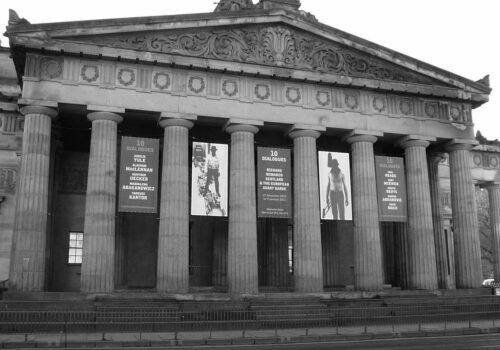
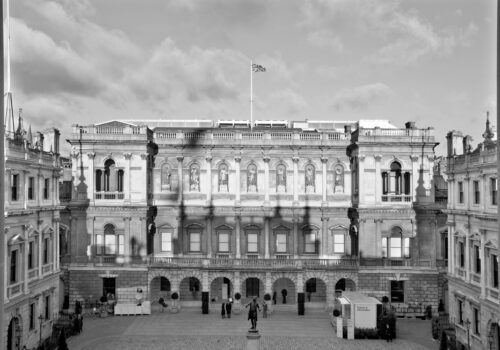

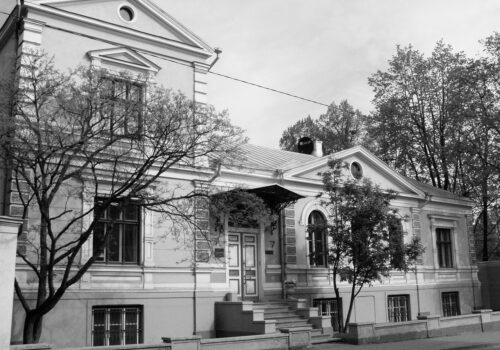
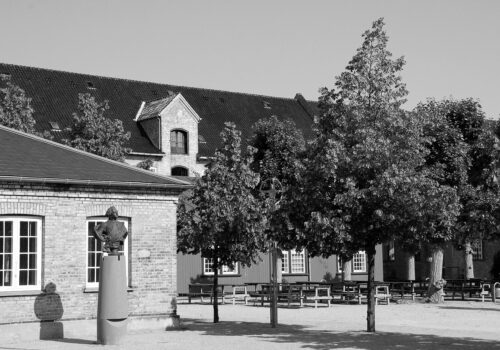
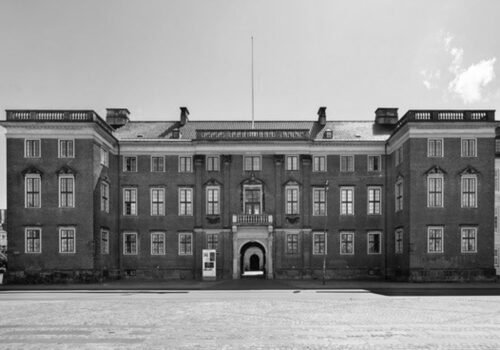





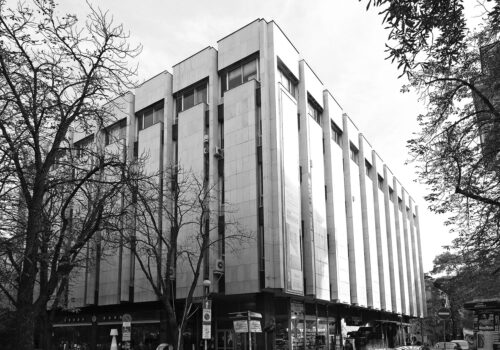

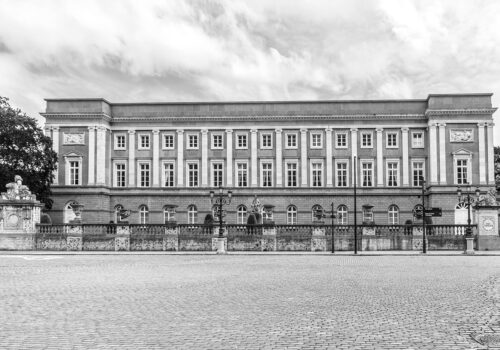



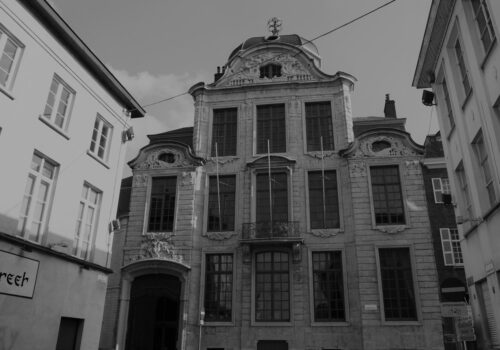

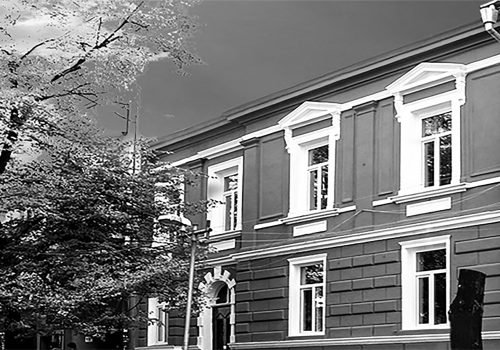
Partners
filter countries:
Austria
-
Akademie der Bildenden Künste WienAcademy of Fine Arts Vienna
-
The Academy of Fine Arts Vienna has been one of the internationally most important educational institutions for artists in the country for more than 325 years. Based on its leading position in Central Europe, the Academy applies high quality standards and compares to the best art universities in the world in order to attract teachers and students from all over the globe.
We offer our approximately 1,500 students a range of curricula that span from painting and sculpture to photography, video, performance, and conceptual art and also include architecture, stage design, as well as conservation and restoration.
The Academy’s Paintings Gallery and Graphic Collection rank among Austria’s most significant art collections. Engaging with these sheds light on how artists of the past pursued their studies and helps to individuate one’s profile by critically examining the historical legacy. At the same time, the Academy’s exhibition practice focuses on contemporary perspectives and approaches.
Homepage: www.akbild.ac.at
Photo: Lisa Rastl
-
Berufsvereinigung der Bildenden Künstler ÖsterreichsThe Austrian Association of Visual Artists
-
The Austrian Association of Visual Artists is the oldest professional association and representative body for artists living in Austria. It is based in Schönbrunn Palace in Vienna.
Always open to new ideas and searching for suitable opportunities of mediation, it is our goal to stimulate and support public discussion of questions pertaining to contemporary art while simultaneously advocating for an appreciation of the visual arts in Austria. In the interest of all artists, she advocates transparency and participation in bodies that decide on art and culture.
We use our voting rights in the most important commissions and committees of public institutions. Therefore, the organization is involved in establishing a framework for the conditions of the art profession so that the interests of the artists are taken into consideration.
In the interests of artists, the Professional Association of Austrian Visual Artists is committed to transparency and having a voice on committees that make decisions regarding art. In addition to the imperative presence at important relevant committee meetings and conferences, the association mobilizes its members to push through special interests when necessary.
Homepage: www.art-bv.at
-
IG Kultur ÖsterreichIG Kultur Austria
-
IG Kultur Österreich is the umbrella organisation and the interest group of free cultural initiatives and represents more than 800 cultural initiatives in Austria, which work self-determined and continuously in the field of contemporary cultural mediation and production. Its central task is to improve the working conditions for emancipatory cultural work, which stands for social development free from exclusion and exploitation. We represent the interests of autonomous and socio-cultural cultural initiatives in politics, administration, media and practice. Our aim is to change perceptions of the importance of cultural work and its influence on society – through an approach that sees cultural work as a democratic-political concern, based on the realities of people’s lives and everyday life.
Homepage: www.igkultur.at
-
Universität für künstlerische und industrielle Gestaltung LinzUniversity of Art and Design Linz
-
Art, media and design in all variations: The University of Art and Design Linz (Kunstuniversität Linz) is interface-oriented and unique in bundling a variety of different disciplines, ranging from architecture, fine arts, art education, industrial design, interface cultures and time-based media to studies in art and media theory, cultural studies and design. The University of Art and Design Linz is a lively professional and academic research institution whose core values lie in the fundamental freedom of art and research with a strong commitment to modernism and contemporary art. A strong hands-on approach and a great variety of partnerships with industry and cultural institutions ensure a direct transfer of theoretical knowledge into practical contexts. With four locations in the historic heart of the Upper Austrian capital Linz, the University of Art and Design Linz creates a vivid atmosphere for creativity and interdisciplinary communication. As one of the smallest Austrian universities, the University of Art and Design Linz can provide an academic and artistic environment with a perfect student-tutor ratio and space for individual artistic and professional development.
Homepage: www.ufg.at
Photo: Mark Sengstbratl
Belgium
-
Koninklijke Academie voor Nederlandse Taal en Letteren (KANTL)Royal Academy of Dutch Language and Literature (KANTL)
-
The Royal Academy of Dutch Language and Literature (KANTL) was established in 1886 as an autonomous, independent and multidisciplinary society. Our goal is to study, to practice and to promote the Dutch language and literature. The Academy is a funded by the Flemish government. Next to hosting a significant number of both cultural and scholarly events, the KANTL publishes articles and monographies in the field of linguistics and literary studies. Every year the Academy awards both an exceptional scholarly study and a remarkable literary work.
Every five years the KANTL presents a literary canon of the Dutch literature. This list of fifty essential literary works is a guideline for teachers, reading clubs, libraries, publishers, policy makers and the general reading audience.
Homepage: www.kantl.be
-
Académie royale des Sciences, des Lettres et des Beaux-Arts de BelgiqueRoyal Academy of Science, Letters and Fine Arts of Belgium
-
Founded in 1772, the Académie royale des Sciences, des Lettres et des Beaux-Arts de Belgique is one of the oldest institutions in the country. It is currently under the high patronage of the King and integrated into the administration of the Ministry of the Wallonia-Brussels Federation. The Academy’s main mission is to promote scientific and artistic research and to support initiatives that, in these fields, require its material and moral assistance.
In this spirit, the Academy constantly strives to encourage cooperation within the Wallonia-Brussels Federation between Belgian and foreign scholars and artists. It awards numerous scientific and artistic prizes and grants. Moreover, with its own publishing house, the Academy publishes the work of its members as well as that of deserving researchers, and provides informed opinions for public authorities. Finally, through the Collège Belgique, created in 2009 under the patronage of the Collège de France, the Academy organises a wide range of lectures and other public events, offering everyone—whether curious minds, newcomers or researchers—access to research and culture.
The Academy comprises more than 350 members, both Belgian and foreign, divided into four divisions: Sciences, Arts, Letters and Moral & Political Sciences, and Technology & Society. It also includes a group of young members known as the Collegium.
Homepage: www.academieroyale.be
-
Palais des Beaux-Arts de Bruxelles (BOZAR)Centre for Fine Arts of Brussels (BOZAR)
-
The Centre for Fine Arts of Brussels (BOZAR) is one of the leading art institution in Belgium. Since 1928, it has implemented a multidisciplinary programme covering visual arts, music, performing arts, cinema, or literature. Its rich programme attracts over 1,3 million visitors and is based on 200 partnerships with the cultural world across Europe and beyond. Its unique position in the capital of Europe has enabled it to develop a strong platform to connect citizens, artists and policy-makers through innovative initiatives. BOZAR’s programme is increasingly focusing on societal challenges such as environment, well-being, heritage, or science. Its European projects in particular have opened up new formats and themes that have impacted on its artistic programmes. At policy level, BOZAR has strengthened its position as a fierce advocate of culture at local, national, EU and international levels (eg. UN).
Homepage: www.bozar.be
-
Académie royale de langue et de littérature françaises de BelgiqueRoyal Academy of French Language and Literature of Belgium
-
Homepage: www.arllfb.be
-
Koninklijke Vlaamse Academie van België voor Wetenschappen en KunstenRoyal Flemish Academy of Belgium for Science and the Arts
-
The KVAB (Royal Flemish Academy of Belgium for Science and the Arts) is the Flemish Academy, a Royal Scientific Society founded in 1772, whose key task is to think and debate about matters of social, scientific and artistic importance in an open and interdisciplinary manner.
The Royal Flemish Academy of Belgium is an autonomous scientific-cultural society that promotes scholarship, science and the arts and contributes to their appeal. As an Academy, it is unique in that, apart from the sciences and the humanities, it also embraces the arts and the engineering sciences. As a result of this interdisciplinary approach, the KVAB is well-positioned to promote the great value of science and the arts.
Homepage: www.kvab.be
Bulgaria
-
Националната художествена академияNational Academy of Art Sofia
-
The National Academy of Art in Sofia was established in 1896 and figures as one the oldest academies in Southeastern Europe. To this day, it continues to be the most prestigious Bulgarian institution for training professional artists in the fields of fine and applied arts, design, restoration, and history and theory of art. The Academy consists of two faculties: Faculty of Fine Arts and Faculty of Applied Arts, which offer advanced training in numerous BA, MA and PhD programs. The buildings of the Academy are located at 4 addresses in Sofia, and in 2018 a new branch was opened in the seaside town of Burgas.
Homepage: www.nha.bg
-
Съюзът на българските художнициUnion of Bulgarian Artists
-
The Union of Bulgarian Artists is a non-profit private organization of professional artists and art critics.
Currently there are about 3000 members of the Union, organized in 17 sections: Painting, Print and illustration, Sculpture, Art criticism, Advertising design, Stage design, Restoration, Monumental arts, Design, Ceramics, Graphic design, „13“ – non-conventional forms, Wood carving, Jewelry, Textiles, Cartoon.
Regional offices of the Union bring together members on territorial principle.
UBA supports the implementation of projects of its members, provide them information and assists the contacts in the art area. Each member can benefit from social programs of the Union.
UBA has the largest exhibition complex in Sofia – four halls in „Shipka“ 6 Gallery and a large hall in „Rayko Alexiev“ Gallery, which present individual, collective, visiting, prestigious international events and avant-garde exhibitions.
The UBA is a member of AIAP, ICOMOS, IKOGRADA, AIKA.
Homepage: www.sbhart.com
-
Институт за изcлeдвaнe нa изкуствaтa Българска академия на наукитеInstitute of Art Studies – Bulgarian Academy of Sciences
-
The mission of the Institute of Art Studies is to study the problems of the arts, architecture and culture in a regional, European and global context; to study and make sense of cultural heritage and national identity. The Institute studies the history, theory and development of the arts, architecture and culture; archival funds are collected, described, systematized, analyzed and stored; conditions are created for their effective use for scientific and cultural purposes and for their presentation to the public.
Homepage: www.artstudies.bg
Croatia
-
Hrvatsko društvo likovnih umjetnika (HDLU)Croatian Association of Artists (HDLU)
-
The Croatian Association of Artists (HDLU) is a nongovernmental, not-for-profit, and politically neutral union of professionals. Its membership consists exclusively of around 2.000 visual artists of all generations, working in all forms of expression and disciplines. The Association was established in 1868 and has been continuously active since then. Basic aims of the Association are: to support and encourage contemporary visual expression, to improve and protect the freedom of visual expression, to organize exhibitions, and to participate in the making of the laws and rules regulating visual arts production and the social rights of the artists. HDLU runs 4 differently profiled galleries out of which 3 are located in a cultural heritage site in central Zagreb – Meštrović Pavilion.
Homepage: www.hdlu.hr
Czech Republic
-
Akademie múzických umění v Praze (AMU)Academy of Performing Arts in Prague (AMU)
-
The Academy of Performing Arts in Prague (AMU) is the largest art school in the Czech Republic. Thanks to its broad scope ranging from theatre, music and dance to TV and movie production, AMU is a diverse and nurturing space for young artists to discover, master and further develop any talents they might possess.
The university is divided into 3 independent departments – each specialized in its own genre of artistic endeavour: The Theatre Faculty (DAMU), the Film and TV Faculty (FAMU) and the Music and Dance Faculty (HAMU). AMU offers accredited study programmes in English as well as short-term individual internships, exchange programmes, specialized courses and opportunities to study abroad.
AMU maintains agreements with a variety of European universities, art and research centers and with educational and art institutions outside of the EU.
Homepage: www.amu.cz
-
České literární centrumCzech Literary Centre
-
The “České literární centrum” (Czech Literary Centre) under the leadership of Martin Krafl is a state-funded organisation that supports and promotes Czech literature abroad and in the Czech Republic. The centre, based in Prague, is a department of the Moravian Library, Brno. It promotes various forms of literature and acts as an information hub for foreign publishers, translators, specialists in Czech studies, organisers and others interested in Czech literature. In addition to its supporting activities, the Czech Literary Centre operates the bilingual website CzechLit.cz with information about books, authors, grants, residencies and news on Czech literature, and also holds the annual Susanne Roth Award for young translators of Czech literature.
Homepage: www.czechlit.cz
Denmark
-
Det Kongelige Danske Kunstakademi – BilledkunstskolerneThe Royal Danish Academy of Fine Arts
-
Homepage: www.kunstakademiet.dk
-
Det Kongelige Akademi – Arkitektur, Design og KonserveringThe Royal Danish Academy – architecture, design and conservation
-
The Royal Danish Academy – architecture, design and conservation was founded in 2011 on the basis of a merger between the Royal Academy’s School of Architecture (1754), the Danish Design School (1875) and the Academy’s School of Conservation (1972). Today KADK have approx. 1600 students on our Bachelor, Master’s, PhD.
KADK unites three fields of knowledge: academic research, artistic research and professional practice as three different ways to discover, invent and create. These three fields are closely interlinked in the education, enabling us to develop graduates and knowledge, which match the needs of the profession, while contributing world-class research, ground-breaking artistic design and new experimental understanding.
Since 2016 we have been working with The UN Sustainable Development Goals.
Please have a look at our latest graduation projects.
Homepage: www.kglakademi.dk
Estonia
-
Eesti Kirjanike LiitEstonian Writers Union
-
Estonian Writers Union is the official organisation of Estonian writers, critics and literary scholars with more than 300 members; the Tartu department also covers Southern Estonia. Estonian Writers Union mediates state support and residency grants to its members and runs all year long event programmes of literary events on its premises in Tallinn and Tartu, with funding from Estonian Cultural Endowment (and also the city of Tartu in case of Tartu Literature House). In Estonia, the union is the main advisor concerning policies affecting writers and literati, and also an active participant in Baltic and European networks. The Tartu department is one of the key partners in the activities of Tartu as UNESCO City of Literature and in devising city cultural policies in favour writers and reading. Berk Vaher was also the chief editor of the successful Tartu 2024 European Capital of Culture bid and is currently also a member of the Creative Council of Tartu 2024.
Homepage: www.ekl.ee
-
Eesti KunstiakadeemiaEstonian Academy of Arts
-
Established in 1914, the Estonian Academy of Arts is the only public university in Estonia providing higher education in fine arts, design, architecture, media, visual studies, art history, and conservation. Estonian Academy of Arts collaborates with more than a 100 partner universities in the world. While most partners are located in Europe, we also have active collaboration with partners in Canada, USA, Australia, New Zealand, Chile, Thailand, China, Japan etc.
67% of our alumni have studied or conducted a traineeship abroad, participating in short- and long term mobility programmes and each year we host roughly 100 incoming exchange students. EKA takes actively part in ERASMUS+ and ERASMUS+ International Credit Mobility programmes. EKA’s outgoing student mobility is of the highest ratio among public universities in Estonia. Outgoing and incoming student mobility has been in good balance. Feedback from incoming exchange students shows that the EAA is highly valued for its small study groups and individual approach by highly professional academic tutors.
EKA’s rector Prof Mart Kalm is a member of the board in ELIA association, Vice Rector Anne Pikkov is a member of the board in CUMULUS and Kristjan Mändmaa in CIRRUS network. Between 2014 – 2023 the EKA also hosts the secretariat of Nordic design education collaboration network CIRRUS. EKA is also an active member in CUMULUS, leading a Fashion and Design working group of the association, ELIA, EAAE, KUNO and other smaller international speciality networks and associations. As of 2020, EKA participates in Transform4Europe European Universities initiative.
Homepage: www.artun.ee
Finland
-
Suomen Taiteilijaseura – Konstnärsgillet i FinlandArtists’ Association of Finland
-
The Artists‘ Association of Finland is the umbrella organisation for visual artists. Through our member organisations we represent over 3 000 professional artists in Finland. We work to secure policy and legislative change to encourage the growth and development of the sector.
Homepage: www.artists.fi
-
Frame Contemporary Art FinlandFrame Contemporary Art Finland
-
Frame Contemporary Art Finland is an advocate for Finnish contemporary art. We support international initiatives, facilitate professional partnerships, and promote the visibility of Finnish art abroad through grants, a visitor programme and residencies, seminars and talks, exhibition collaborations and network platforms. Frame is the commissioner of Finland’s participation at the Venice Biennale.
The underlying values of our work are equity, freedom of speech and diversity within the arts.
Our ongoing public programme includes Rehearsing Hospitalities, a series of events and publications for years 2019–2023. The programme connects curators and other practitioners in the field of contemporary art and beyond to build up and mediate new practices, understandings and engagements with diverse hospitalities.
Frame supports the networking of Finnish contemporary art professionals by inviting international art professionals to visit Finland. Our guests include curators, researchers and cultural producers. We tailor an individualised programme for each guest based on their interests.
Homepage: www.frame-finland.fi
France
-
Académie des beaux-artsFrench Academy of Fine Arts
-
The Académie des beaux-arts (French Academy of Fine Arts) is one of the five academies that make up the Institut de France (Institute of France). Composed of 67 members, 16 foreign associate members and 67 correspondents, it promotes artistic creation through all forms of expression, notably by organizing competitions, awarding annual prizes, funding artist residencies, distributing grants and working to champion France’s cultural heritage. A consultative body for the public authorities, it also considers artistic issues.
In order to fulfill these roles, the Académie des beaux-arts maintains a portfolio of assets made up of gifts and bequests, and also runs major cultural foundations such as the Musée Marmottan Monet (Marmottan Monet Museum) in Paris, Claude Monet’s House and Gardens in Giverny or the Villa and gardens Ephrussi de Rothschild (Saint-Jean-Cap-Ferrat).
Homepage: academiedesbeauxarts.fr
Photo: © H&K / Micha Henrotte
Germany
-
Bayerische Akademie der Schönen KünsteBavarian Academy of Fine Arts
-
The Bavarian Academy of Fine Arts is an organisation of renowned personalities from the world of art. It was founded in 1948 by the State of Bavaria as the „uppermost patron of the arts“, in order „to constantly observe the development of the arts, to promote them in any way it deems appropriate or to make suggestions for their promotion“, as the founding regulation states. The Academy is structured in five departments: Fine Arts and Architecture, Literature, Music, Performing Arts, and Film and Media Arts. Winfried Nerdinger is President of the Academy since autumn 2019. He is supported by the directors of the departments (Directorate) and the General Secretary. The Academy runs an extensive annual programme with individual lectures, lecture series, panel discussions, concerts, readings, exhibitions and award ceremonies for outstanding artists. Interdepartmental meetings also serve the purpose of getting to know each other and exchanging information between members, among other things about the respective thematic priorities.
Full members of the Academy can become artists and personalities who are open to artistic questions. Anyone who has contributed to art in an outstanding manner can be appointed as an honorary member.
Homepage: www.badsk.de
-
Akademie der KünsteAcademy of Arts
-
The Akademie der Künste is an exhibition and event location, a meeting place for artists and people interested in the arts, where public debates on art and cultural policy take place. A key part of the Academy is its Archive. With over 1,200 bequests by artists and an extensive art collection and library, the Archive is one of the most important interdisciplinary archives of 20th century art.
The event programme of the Academy serves to present contemporary artistic positions to the public and is dedicated to safeguarding cultural heritage. In its two permanent locations in the heart of Berlin – Pariser Platz in the Berlin-Mitte district and Hanseatenweg in Tiergarten – the Academy shows exhibitions, organises concerts, debates, readings, awards ceremonies, as well as film, theatre, and dance performances.
Homepage: www.adk.de
-
Berlin-Brandenburgische Akademie der WissenschaftenBerlin-Brandenburg Academy of Sciences and Humanities
-
The Berlin-Brandenburg Academy of Sciences and Humanities is a learned society with a three-hundred-year-old tradition of uniting outstanding scholars and scientists across national and disciplinary boundaries. 80 Nobel Prize winners have shaped its history. As the largest non-university research institution for the humanities in the Berlin-Brandenburg region, it preserves and reveals the region’s cultural inheritance, while also pursuing research and offering advice on issues that are crucial for the future of society and providing a forum for dialogue between scholarship and public.
Homepage: www.bbaw.de
-
Deutsche Film- und Fernsehakademie Berlin (DFFB) The German Film and Television Academy Berlin (DFFB)
-
The German Film and Television Academy Berlin (DFFB) is one of the most prominent film schools in Europe. Founded in 1966, it has been an academy of screen technique and a production atelier for new voices and ideas in film and television ever since. Focusing on the essential crafts of filmmaking, the academy offers five specializations in Screenwriting, Cinematography, Directing, Producing and Editing & Sound. Open to teachers, students, cultural influences, techniques and emerging platforms from all over the world, the DFFB study programme sets intense and collaborative standards including the development of practical skills, growing knowledge of film history and a deep understanding of the economic conditions of the film and television industry. Each year, DFFB films travel to around 200 film festivals worldwide. The academy also offers attractive training and networking opportunities through its internationally oriented programmes Serial Eyes, Next Wave and Filmnetzwerk Berlin.
Homepage: www.dffb.de
-
Europäische Akademie BerlinEuropean Academy Berlin
-
As a disseminator of knowledge the European Academy Berlin explains policies and politics and communicates European values since 1963. By strengthening the critical ability of each individual citizen, the EAB in this way contributes towards a vital civil society in Berlin, in Germany and in Europe.
In Berlin, the Academy is a well-established location for meetings of all kinds for an international clientele – always addressing current and relevant topics. It does so aiming at the highest standards of substantial and pedagogic-didactic objectives. In its work the Academy is characterized by an excellent team – both in the educational as well as seminar and project management fields. The historic Academy building is a venue for seminars and conferences. Built in 1928 and extended in 1968 and 1978 it symbolizes the drastic changes Berlin, Europe and the world have seen in the 20th Century.
Homepage: www.eab-berlin.eu
-
European Film AcademyEuropean Film Academy
-
The European Film Academy (EFA) unites 3,800 European film professionals with the common aim of promoting European film culture. Throughout the year, the EFA initiates and participates in a series of activities dealing with film politics as well as economic, artistic, and training aspects. The programme includes conferences, seminars and workshops, and a common goal is to build a bridge between creativity and the industry. These activities culminate in the annual presentation of the European Film Awards. Since its early beginnings, Berlin has been the seat of the EFA Secretariat where it is registered as a non-profit association.
EFA is a member of FAN (Film Academies Network) of Europe and one of the three initiators of the International Coalition for Filmmakers at Risk (ICFR).
Homepage: www.europeanfilmacademy.org
-
Universität der Künste BerlinBerlin University of the Arts
-
Berlin University of the Arts is one of the largest and most diversified universities of the arts in the world. The teaching offered mostly in traditional formats in the four colleges of Fine Arts, Architecture, Media and Design, Music and Performing Arts as well as at the Central Institute for Continued Education/ Berlin Career College as well as the inter-University centres for Dance (HZT) and Jazz (JIB) encompasses the full spectrum of the arts and related academic studies in more than 70 courses. With the right to confer doctorates and post-doctoral qualifications, Berlin University of the Arts is also one of the few art colleges in Germany with full university status. Teachers in art and music are also educated at Berlin University of the Arts, the only university in Berlin where these subjects can be studied.
Homepage: www.udk-berlin.de
-
weißensee kunsthochschule berlinweissensee school of art and design berlin
-
The weissensee school of art and design berlin was founded in 1946. Building on the ideas and teaching of the Bauhaus movement, the school stands out because of its unique profile. It offers more than 800 students a one-year, interdisciplinary course of foundation studies, followed by diploma studies in free art as well as bachelor and master’s degrees in design. With its cross-disciplinary teaching and research the weissensee school of art and design berlin provides excellent courses of study. Its development projects in the fields of art and design make a significant contribution to relevant processes of change in society. The students and members of the school see themselves as an international community which, in collaborating in a way that is practice-oriented, also shapes the freedom of art and science in its research and teaching and promotes intellectual and cultural discourse. It takes a clear stand against right-wing radicalism, anti-democratic tendencies and discrimination. As a place for social interaction – in times of crisis too – the school promotes a culture of togetherness and solidarity.
Homepage: www.kh-berlin.de
-
Deutsche Akademie für Sprache und DichtungGerman Academy for Language and Poetry
-
The German Academy for Language and Poetry, founded in 1949, gathers around 200 German-language writers, translators, critics and scholars from Germany and abroad. In addition to awarding prizes, including the Georg Büchner Prize for German-language literature, the Academy also follows the development of German language and literature. It takes part in cultural policy debates, also in cooperation with other German academies. At its conferences abroad, it maintains a dialogue with authors from other countries and exchanges with its European sister academies. With international event formats such as the cycle „Europe in Poetry“ or the series „Debates on Europe“ (together with the S. Fischer Foundation), it seeks to contribute to a lively open Europe. The Academy’s work is financed by the Federal Government Commissioner for Culture and the Media, the State of Hesse, the Cultural Foundation of the Federal States and the City of Darmstadt, where the Academy is based.
Homepage: www.deutscheakademie.de
More Information on „Debates on Europe“: www.debates-on-europe.eu
-
Filmuniversität Babelsberg KONRAD WOLFFilm University Babelsberg KONRAD WOLF
-
The Film University Babelsberg KONRAD WOLF is a lively place of independent research, teaching and art. Founded in 1954, it is now the largest film school in Germany with an international reputation. In July 2014 it was the first to achieve university status. With its unique interdisciplinary educational profile, successful artistic productions and innovative research projects, the Film University makes a decisive contribution to the future of moving image media. Knowledge and insights, innovative audiovisual formats, but also services, technologies, ideas and experience are transferred to companies and society. Furthermore, the only art university in the state of Brandenburg is a place of cultural and political debate. The Film University is an integral part of the Babelsberg Media City and closely linked to the metropolis of Berlin. No other place in Germany offers a stronger connection between the past, present, and future of filmmaking. Here, creative, technical, teaching and research competence at a high level is complemented by excellent networks and an efficient funding structure.
Homepage: www.filmuniversitaet.de
-
Freie Akademie der Künste HamburgFree Academy of Arts Hamburg
-
Founded in 1950, Freie Akademie der Künste in Hamburg has been an active player in the field of cultural and educational policy for more than seven decades. In line with its purpose, the firm commitment to freedom and claim of art is one of the primal tasks of the institution. It speaks up for artistic expression free of governmental censorship and political interference.
The Akademie sees itself as a cultural counterpart to political institutions, giving advice and intervening in controversial cultural issues. It provides support for all genres of arts and tries to sustain their singularity beyond zeitgeschmack and commercial constraints. In this sense, the Akademie also acts as a counterpoise to the commercial art scene, which is to a large extent determined by non-artistic interests.
Homepage: www.akademie-der-kuenste.de
-
Hochschule für Bildende Künste DresdenDresden University of Fine Arts
-
At Dresden University of Fine Arts, around 580 students pursue studies in fine arts, art technology, preservation and restoration of artistic and cultural assets, stage and costume design, theatre design, and at the post graduate-level course art therapy. This study profile is complemented by instruction in art history, philosophy/aesthetics, architecture and space design, and theatre studies.
Founded in 1764 as the Haupt-Kunstakademie, it is one of Europe’s oldest art schools. Moreover, the institution has an extensive network of links to art schools and other artistic and academic institutions around the world.The faculty and its students participate actively in international contemporary art and discourse about issues pertaining to art and society.
Furthermore, Dresden University of Fine Arts is a member of EU4ART, a European University Alliance of art academies in Budapest, Rome, Riga and Dresden. The EU4ART Alliance supports the exchange of experience among students, academic and administrative staff in and through the fine arts in order to support emerging artists and foster innovation and unpredictability on all levels relevant to the arts and their influence on European society.
Homepage: www.hfbk-dresden.de
-
Sächsische Akademie der KünsteSaxon Academy of Arts
-
The Saxon Academy of Arts brings together renowned artists and art scholars from Germany and abroad. It concentrates on five categories: architecture, the visual arts, the performing arts and cinema, literature and language cultivation, and music. Its key activities include facilitating dialogue between artists, consideration of the future of art and culture in the Saxon cultural area, and cultural bridge-building with the countries of Central and Eastern Europe.
The Saxon Academy of Arts, founded in 1996 as an institution of the Free State of Saxony, is the youngest of Germany’s arts academies set up by regional government. As set out in the preamble of its statutes, its work is guided “by the will, through reflection on the arts, to gain images from present and past which are dedicated to a dignified future and, supported by the strengths of the Saxon cultural area, to encourage notions of how German culture, tightly knit into the international community, can contribute to the integration of society.
The Saxon Academy of Arts “supports artistic freedom and expectations vis-à-vis the state and society, and publicizes significant artistic achievements, positions and processes of the present day. In order to further its aims, the Academy maintains links with other artistic societies and individuals.” (Section 1(1, 2) of the statutes of the Saxon Academy of Arts)
Homepage: www.sadk.de
Greece
Hungary
-
Széchenyi Irodalmi és Művészeti AkadémiaSzéchenyi Academy of Letters and Arts
-
The Széchenyi Academy of Letters and Arts was established in 1992 by the Hungarian Academy of Sciences, as an associated but autonomous body with statutes of its own. The foundation was part of a rehabilitation process that aimed at the inclusion of eminent representatives of literature, music and art as these fields had been excluded from the Academy of Sciences in 1949. For constitutional reasons, however, a separate arts academy was founded.
Membership is by invitation. Members are elected by the Annual General Assembly. At any one time, the number of full members under the age of 70 must not exceed 60. Members of the Széchenyi Academy pay no membership fee and receive no revenue.
The Academy has five departments: (1) Literature, (2) Fine Arts, (3) Musical Arts, (4) Cinematic and Theatre Arts, and (5) Architecture.
The total number of the members is around 130. The president of the Széchenyi Academy is Dóra Maurer artist.
Homepage: www.mta.hu/szima
-
Szépírók TársaságaSociety of Hungarian Authors
-
The Society was established in 1997 to promote contemporary literature and democratic cultural policies. Its more than 400 members include some of the internationally most acclaimed Hungarian writers as well as cultural journalists and cultural managers from across Hungary, and also writers and critics of the Hungarian minorities and diasporas, along with international translators and scholars of Hungarian literature. It organies readings, conferences, festivals and other cultural events within and beyond the borders of Hungary. It has collaborated with a long list of Hungarian and international organizations.
Homepage: www.szepiroktarsasaga.hu
Ireland
-
Royal Hiberian AcademyRoyal Hiberian Academy
-
The RHA was founded in 1823 for the betterment of the visual arts in Ireland, The membership comprises of 30 full members and 10 associate members and is self electing. The RHA provides a changing exhibition programme of contemporary art, hosts an annual exhibition now is its 190th year. It provides professional development through accredited classes, masterclasses and a individual studio programme, It has a comprehensive public engagement programme.
Homepage: www.rhagallery.ie
Italy
-
Accademia delle Arti del Disegno Academy of the Arts of Drawing
-
Disegno is based in Firenze, Italia. The Accademia e Compagnia delle Arti del Disegno („academy and company of the arts of drawing“), was founded on 13 January 1563 by Cosimo I de‘ Medici, under the influence of Giorgio Vasari. Its premises include an ancient palace in the very city centre „Palazzo dei Beccai“) and an exhibition gallery. It is the owner of works of art, a library and archives. The Academicians are divided into four classes of membership: emeritus, ordinary, correspondent and honorary. The present mission of the Accademia delle Arti del Disegno includes the promotion and diffusion of the arts and sciences, and the protection and conservation of cultural heritage worldwide. Since the statute of 1978 the Accademia delle Arti del Disegno has been divided into five classes: painting, sculpture, architecture, history of art and humanities and sciences, each of which develops specific programs. Distinguished personalities from all over the world are associated as honorary members The Accademia organises conferences, concerts, book presentations and art and sciences exhibitions. It operates in connection with cultural nets both in the service of the City of Florence, and in a worldwide perspective.
Homepage: www.aadifi.it
Latvia
Lithuania
-
Vilniaus dailės akademijaVilnius Academy of Arts
-
Vilnius Academy of Arts (VAA) is the only higher education facility in Lithuania dedicated to professional and academic education in visual and applied arts. With teaching departments in four cities, the VAA offers BA and MA programs in a variety of artistic disciplines, ranging from visual arts and crafts to architecture and design (backed up by the Design Innovation Centre). The VAA also runs an Art History and Curating program, as well as its own Art Research Institute and PhD programs in both Art Practice and Art History. The VAA also has its own publishing house and a number of gallery spaces with regular programming.
Homepage: www.vda.lt
Luxembourg
-
D’Filmakademie LuxembourgLuxembourg Film Academy
-
Founded in 2012, the aim of the Luxembourgish Film Academy (d’Filmakademie) is to encourage national cinematographic creation, to promote Luxembourgish cinema, to increase its visibility with the public, and to serve as a consultative body between the members of the film sector represented in its Board:
The associations of film technicians (ALTA), directors and screenwriters (LARS), actors (ACTORS .LU), producers (ULPA), animation film professionals (FMAIV), music composers (FLAC), as well as the National Film Fund and the Centre National de l’Audiovisuel (CNA).
In collaboration with the Film Fund Luxembourg, the Academy organizes the national film awards (Lëtzebuerger Filmpräis) every two years.
Homepage: www.dfilmakademie.lu
-
Institut Grand-Ducal de Luxembourg Section des Arts et des LettresInstitut Grand-Ducal de Luxembourg Section of Arts and Letters
-
The Arts et Lettres Section is a part of the Institut Grand-ducal, founded in 1868 by the fusion of three scientific societies, of archeology, natural sciences and medicine; three more sections were added until now, ethnology (in 1935), art and literature (in 1862), moral and political sciences (in 1966). So the Institut Grand-ducal includes now six sections, acting all independently. The Arts et Lettres Section itself covers different domains, six in total, in the so-called sous-sections, of the three languages and literatures: French, German and Luxembourgish (according to the special linguistic situation of the country), theatre and film, music and architecture together with visual arts. The section in total has 40 coopted members; they meet twice a year, in July and December, while the normal operation is done by a bureau of three members: chairman, Lucien Kayser; secretary, Edmond Thill; treasurer, Alex Reuter. According to the statutes of the institution, the aim of the Arts et Lettres Section is the encouragement of culture in general, of sciences, literature and arts.
Homepage: www.artsetlettres.lu
Malta
Netherlands
-
Koninklijke Nederlandse Akademie van Wetenschappen (KNAW)Royal Netherlands Academy of Arts and Sciences
-
The Society of Arts forms part of the Royal Netherlands Academy of Arts and Sciences. The Society of Arts was established in 2014 with the aim of establishing a dialogue between the (fine) arts and the sciences. It comprises 50 members from a wide range of disciplines: writers, designers, choreographers, film makers, photographers, visual artists, etc. Members are selected because of their artistic merits.
The Society of Arts was founded with the aim of establishing a dialogue between the arts and sciences, but also to foster conversation between the arts and politics, the arts and education, and between the different art disciplines themselves. To do so, the Society organize a vast number of public debates, every year. The topics range from all kinds of social issues (e.g. climate, racism, basic income) to ones that pertain to the arts specifically. Members of the Society participates in numerous steering and advisory committees, for instance the national committee on the labour market in the Dutch art world. In addition to the organization of public debate and the representation in working groups and committees, the Society also provides policy makers with advice. It has established a series of ‘cahiers’ in which individual members are invited to express their views on certain topics, ranging from the artist’s underpayment up to the future of the public domain
Homepage: www.knaw.nl
Poland
-
Polska Akademia Nauk Komitet Architektury i Urbanistyki (KAiU)Polish Academy of Sciences Committee for Architecture and Town Planning (KAiU)
-
Homepage: www.pan.pl
-
Europejskie Centrum SolidarnościEuropean Solidarity Centre
-
The European Solidarity Centre Gdańsk (ECS) is a cultural institution with its aim to promote the knowledge about the peaceful victory of Solidarność. Since the opening of its building in August 2014, the ECS has welcomed 4.8 million visitors from all over the world, making it one of Poland’s biggest tourist attractions. The ECS is also the only cultural institution in Poland honoured with the Council of Europe Museum Prize (2016), which has been awarded annually for over 40 years to museums that have made a significant contribution to the understanding of Europe’s cultural heritage.The heart of the ECS is a permanent exhibition dedicated to the history of Solidarność and the changes in Central and Eastern Europe. The ECS features an education centre, a research centre, an archive, a library and a media center. Last but not least, it is a public space, a venue for hands-on solidarity and civic engagement; a meeting place for citizens who feel responsible for the development of democracy.
Homepage: www.ecs.gda.pl
-
Akademia Sztuk Pięknych w GdańskuAcademy of Fine Arts in Gdańsk
-
The Academy of Fine Arts in Gdańsk is the largest artistic Academy in the North of Poland, with 75 years of tradition. It has great pleasure in educating new creators, who participate in the most important events in the areas of culture, art, and design, locally, nationally and abroad. The Academy of Fine Arts is located in the main old town of historical Gdańsk in monumental buildings (the Great Armoury, the English House, the Small Armoury, the Thatch Bastille). Currently at the AFA in Gdańsk study approx. 800 students on both undergraduate and postgraduate levels, on following courses: Design, Design of Cultural Landscapes, Interior Design, Graphics, Intermedia, Painting, Sculpture
The Academy of Fine Arts in Gdańsk employs more than 150 academic staff, with a broad experience and achievements in the area of art and design, which open to the students the richness of artistic techniques, means of communication and the newest methods of design. In December 2015 there was an opening of the Armoury of Arts, which bases on the ground floor of the Great Armoury, and within a framework of which the Academy presents a cultural offer of exhibitions, workshops, lectures, debates, conferences and special events. Armoury of Arts project is an expansion of cultural activities of AFA in Gdańsk.
Homepage: www.asp.gda.pl
Portugal
-
Fundaçao Calouste GulbenkianCalouste Gulbenkian Foundation
-
Since its establishment, in 1956, the Calouste Gulbenkian Foundation has been deeply committed to the values of artistic freedom, creative innovation, transnational cooperation and intercultural dialogue. Arts and Culture have always been at the very centre of our philanthropic mission, as part of a general strategy guided by the high ideals of human dignity, democracy, civil rights, social inclusion and solidarity. We strongly believe that much of Europe’s potential worldwide lies on the richness of its cultural diversity, and on its unique capacity to act as a large platform for a permanent, dynamic and peaceful interaction between its many cultural traditions, beyond any internal geopolitical boundaries. It is therefore with great enthusiasm that we join the project of the European Alliance of Academies as a partnership of multinational institutions sharing the same humanistic and democratic principles and defending the fundamental value of the freedom of the arts.
Homepage: www.gulbenkian.pt
Romania
-
Romanian Association of Contemporary Art (ARAC)Romanian Association of Contemporary Art (ARAC)
-
ARAC (The Romanian Association for Contemporary Art) is a non-profit organization founded in June 2012, in order to produce and promote contemporary art in Romania and abroad. The team of ARAC supports and promotes contemporary Romanian artists by attracting funds in order to ensure financial resources – as part of ARAC’s mission statement. An important objective of ARAC is to facilitate international cultural exchanges with artistic environments from around the world. Through the years, ARAC has organised residency programs (58 Plantelor Residency), exhibitions and published art books while actively investigating and reflecting upon emerging developments in contemporary art and culture.
In the next 2 years, between 2020 – 2022, ARAC will carry out, in partnership with the ARTAK350 residence in Iceland, a large-scale project that aims to expand the local contemporary art scene, through a series of cultural events and artistic residencies. The main topics of discussion set for the project: climate change, economic and war migration, new technologies, the gallery and ARAC aims to develop a dialogue about social developments and their perception at the global level. The exhibitions will be followed by a series of discussions and meetings with guest artists and curators for evenings of video and performance screenings called: “Insomnia Nights“. The 2 year-programme will finalize with the Exhibition of the public, a pilot project for the first time in Romania that further encourages the local public to interact with the gallery portfolio.
Homepage: www.arac.ro
Slovakia
Slovenia
-
Slovenska akademija znanosti in umetnosti (SAZU)Slovenian Academy of Sciences and Arts (SAZU)
-
The Slovenian Academy of Sciences and Arts (SASA), founded in 1938, is the supreme national institution of sciences and arts. It associates scientists and artists, elected its members for their outstanding achievements in the field of sciences and arts. International cooperation is carried out under the auspices of the Department of International Relations and Scientific Coordination of the Slovenian Academy of Sciences and Arts. The Department coordinates cooperation in the fields of sciences and arts with academies and inter-academic associations around the world (on bilateral and multilateral level).
Homepage: www.sazu.si
-
Zveza društev slovenskih likovnih umetnikov Association of Slovene Fine Artists Societies
-
The Association of Slovene Fine Artists Societies was established in 1899 and is a professional association of Slovenian fine artists and one of our oldest fine art societies. During its long and distinguished history it was this Organisation which took the initiative to establish the National Gallery of Slovenia, the Museum of Modern Art, the Academy of Fine Arts and Design, and several smaller galleries, as well as the fine art magazines Umetnost (1936), Sinteza (1964-1994) and most recently Likovne besede / Art Words Magazine (in print since 1985). The Association of artists, with more than 800 members and within six professional sections (Section of Painters, Section of Graphic Artists, Section of Illustrators, Section of art Pedagogues, Section of Ceramics, Section of Photographers, Section for Video and Media Art, Section of Sculptors and Artists, which are Working in Public Space) consists of 9 regional associations of artists from all Slovenian regions and is a kind of service for the members and enable the artists to be in close touch with each other. The Association is composed of members who represent the entire spectrum of the interdisciplinary-oriented contemporary visual arts.
Homepage: www.zdslu.si
Spain
-
Círculo de Bellas Artes (CBA)Círculo de Bellas Artes (CBA)
-
The Círculo de Bellas Artes (CBA) is one of the most important private cultural centres in Europe. A multidisciplinary centre with activities ranging from the visual arts to literature, science, philosophy, cinema and the performing arts.
Known as „Casa Europa“ for its recognized role as a forum for reflection and debate by and for European civil society, the CBA is not only sponsoring an intense debate on key issues of European construction, but is succeeding in taking these issues beyond the academic or political sphere and into civil society.
Homepage: www.circulobellasartes.com
Sweden
Switzerland
-
F+F Schule für Kunst und DesignF+F School for Art and Design
-
The F+F School of Art and Design Zurich is the largest independent art and design school in Switzerland and the second oldest institution of its kind in Europe. It was F+F was founded in 1971 and it this time it was the first progressive art school in Switzerland. Embracing the revolutionary spirit of 1968, it wanted to be a non-elitist alternative for art and design training and welcomed the wider population to its evening and Saturday courses. The teachers were practising artists and designers.
Currently, our 270 students are taught by 200 lecturers, while another 500 persons attend our wide range of courses. The actual education programme focus on Fashion Design, Film, Fine Arts, Graphic Design, and Photography.
Since 2015, the F+F has been offering refugee scholarships. This programme is aimed at talented designers forced to flee their home country. Numerous foundations and donors support this unique training programme.
The School maintains agreements with Schools, Universities and art institutions within and outside the European Union.
As an independent, non-state institution, F+F strives to be inclusive and easily accessible.
Please have a look at our archive: https://ff1971.ch/en
Homepage: https://ffzh.ch
Ukraine
-
НАЦІОНАЛЬНА АКАДЕМІЯ МИСТЕЦТВ УКРАЇНИNational Academy of Arts of Ukraine
-
The National Academy of Arts of Ukraine (NAM of Ukraine) is a high public scientific and artistic institution founded in 1996, according to the Presidential Edict about the establishment of a self-governed academic institution in the field of culture and art. In 2010, with the next Presidential Edict, the Academy gained the status of the national organization.
In total, the Academy is presented today by 104 academicians and members-correspondents. They are divided by profile sections: fine arts, music, film art, history and theory of arts, and synthesis of plastic arts. Besides, there are 38 foreign members and 27 honored academicians.
According to the statutory provisions of the National Academy of Arts of Ukraine, the main activities are the following, among other: conducting fundamental and applied scientific researches on creative art, history and theory of Ukrainian art, art critics, art and esthetic education; conducting exhibitions and other presentation events; developing the scientific and cultural cooperation with foreign scientists and artists; studying and generalizing the scientific and creative experience of national and world culture personalities, promotion of scientific knowledge and creative achievements of the national art at the global level. There are two research institutes under the jurisdiction of the National Academy of Arts of Ukraine: the Modern Art Research Institute (MARI, founded in 2001) and the Institute for Cultural Studies (ICS, founded in 2007).
Today, the National Academy of Arts of Ukraine is a focal point around which artists and scientific researchers of different genres and fields are united, as well as art and culture high schools and centers.
Homepage: www.academia.gov.ua
United Kingdom
-
Royal Academy of ArtsRoyal Academy of Arts
-
Homepage: www.royalacademy.org.uk
